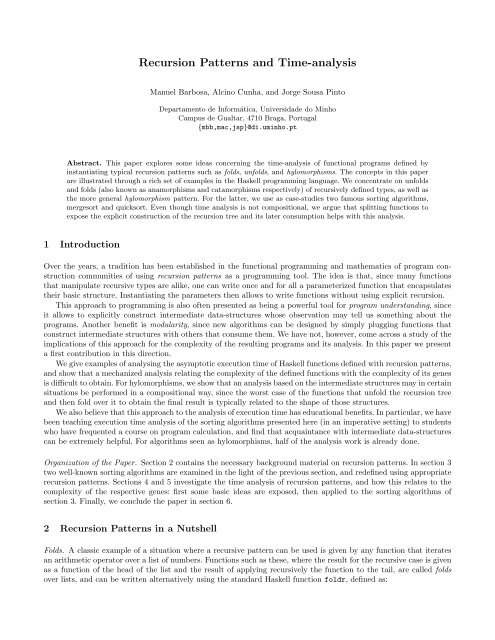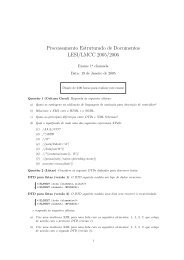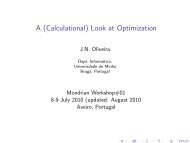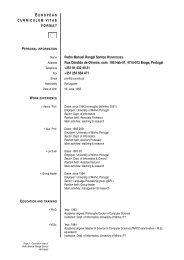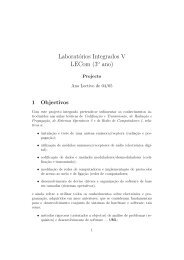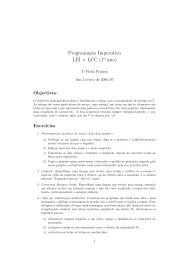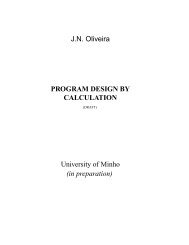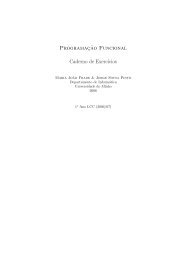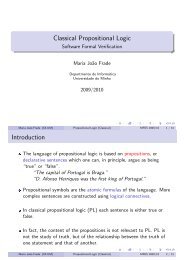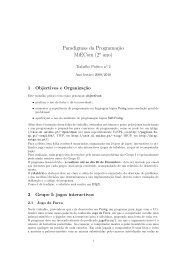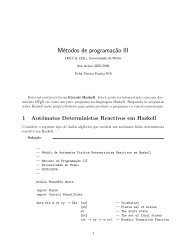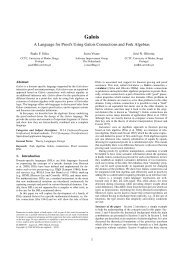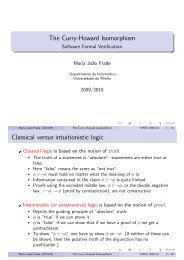Recursion Patterns and Time-analysis - Departamento de ...
Recursion Patterns and Time-analysis - Departamento de ...
Recursion Patterns and Time-analysis - Departamento de ...
Create successful ePaper yourself
Turn your PDF publications into a flip-book with our unique Google optimized e-Paper software.
foldr :: (a -> b -> b) -> b -> [a] -> bfoldr f z [] = zfoldr f z (x:xs) = f x (foldr f z xs)For instance, the function that sums the elements in a list is written as sum = foldr (+) 0.This i<strong>de</strong>a can be generalized for any regular type, the difference being that the programmer will have to writethe appropriate parameterized function that encapsulates the recursion pattern. We exemplify this for two differenttypes of binary trees, respectively leaf-labeled <strong>and</strong> no<strong>de</strong>-labeled, <strong>de</strong>fined as follows.data LTree a = Leaf a | Fork (LTree a) (LTree a)data BTree a = Nil | No<strong>de</strong> a (BTree a) (BTree a)Folds over these trees can be captured by the functions cataLTree <strong>and</strong> cataBTree. In or<strong>de</strong>r to <strong>de</strong>fine these functions,one just has to bear in mind that when processing a no<strong>de</strong> the results of performing recursion on the sub-trees of theno<strong>de</strong> are combined with the contents of the no<strong>de</strong> (if any) to give the final result.cataLTree :: (b -> b -> b) -> (a->b) -> LTree a -> bcataLTree f g (Leaf x) = g xcataLTree f g (Fork l r) = f l’ r’ where l’ = cataLTree f g lr’ = cataLTree f g rcataBTree :: (a -> b -> b -> b) -> b -> BTree a -> bcataBTree f z Nil = zcataBTeee f z (No<strong>de</strong> x l r) = f x l’ r’ where l’ = cataBTeee f z lr’ = cataBTeee f z rOften the arguments of these functions are called the genes of the folds. In the case of binary trees, the genes are pairsof functions, the first of which is used to process no<strong>de</strong>s, <strong>and</strong> the second to process leaves (in fact, for no<strong>de</strong>-labeledtrees, this second component is a constant since there is no information to process in an empty leaf).As examples of folds over trees, let us write the height functions for both types of trees.heightLTree = cataLTree (\ l r -> 1 + (max l r)) (\_ -> 0)heightBTree = cataBTree (\x l r -> 1 + (max l r)) 0Unfolds. In the context of a programming language with non-strict semantics such as Haskell, recursive <strong>and</strong> corecursivetypes coinci<strong>de</strong>. Unfolds st<strong>and</strong> to corecursive programs as folds st<strong>and</strong> to recursive programs (they are dualconcepts); they are however less wi<strong>de</strong>ly used by programmers [4]. Consi<strong>de</strong>r the Haskell function that constructs (wheninvoked with 0) a binary tree where each no<strong>de</strong> is labeled with its <strong>de</strong>pth in the tree, stopping at level 100.inflevels100 100 = Nilinflevels100 n = No<strong>de</strong> n (inflevels100 (n+1)) (inflevels100 (n+1))This function has the property that when a no<strong>de</strong> is returned, both its sub-trees are recursively constructed by thesame function being <strong>de</strong>fined. This clearly indicates that a corecursion pattern is being used, which can be writtenonce <strong>and</strong> for all. The following functions capture these patterns for both types of trees we have been using:anaLTree :: (b -> (Either a (b,b))) -> b -> LTree aanaLTree h x = case (h x) of Left y -> Leaf yRight (a,b) -> Fork (anaLTree h a) (anaLTree h b)anaBTree :: (a -> Maybe (b,a,a)) -> a -> BTree banaBTree h x = case (h x) of Nothing -> NilJust (y,a,b) -> No<strong>de</strong> y (anaBTree h a) (anaBTree h b)
ms_split [] = ([],[])ms_split (h:t) = let (a,b) = ms_split t in (h:b,a)ms_merge l []= lms_merge [] l= lms_merge (ha:ta) (hb:tb) = if ha < hbthen ha:(ms_merge ta (hb:tb))else hb:(ms_merge (ha:ta) tb)This implementation follows the st<strong>and</strong>ard divi<strong>de</strong>-<strong>and</strong>-conquer <strong>de</strong>finition of the mergesort algorithm. The unor<strong>de</strong>redlist is split into two halves, which are sorted recursively. The resulting or<strong>de</strong>red lists are then combined to form acomplete sorted version of the input list. Note the way in which the splitting of the unor<strong>de</strong>red list is ma<strong>de</strong>, due tothe impossibility of accessing list elements r<strong>and</strong>omly.Insight on how to transform a recursive implementation such as this into a hylomorphism comes from analysingits recursion tree. An example of such a tree is shown in figure 1.[1,2,3,4,5,6,7,8][2,3,5,7][1,4,6,8][2,3][5,7][1,8][4,6][2] [3] [5] [7][8] [1][4] [6][2] [3] [5] [7] [8] [1] [4] [6]Fig. 1. Mergesort recursion tree for list [2,8,5,4,3,1,7,6], annotated with the result of each recursive callThe recursion tree of this algorithm can be represented as a binary leaf tree, since in mergesort no data isassociated with intermediate levels in the recursion tree. All input list elements are inclu<strong>de</strong>d in the split lists thatare passed to lower levels in the recursion tree. Similarly, all the data that is required for the combination of thepartial solutions are the sorted sub-lists themselves. <strong>Recursion</strong> stops when the results of splitting are lists with asingle element, which correspond to the leaves of the recursion tree.A direct way of implementing mergesort as a hylomorphism is to use the type LTree introduced in section 2 forthe intermediate data structure, which will thus be a replica of the recursion tree. A suitable anamorphism will thenhave to generate this data structure from the input list. The anamorphisms for this type of tree can be generated bythe function anaLTree of section 2; in particular for the mergesort anamorphism the following function can be usedas gene.f [x] = Left xf lst = Right (ms_split lst)This function generates leaves for the tree whenever a list with one element is encountered, <strong>and</strong> otherwise it producesa pair of lists that will be used to generate two new tree branches.Similarly, a suitable catamorphism will have to consume the intermediate data structure <strong>and</strong> generate the sortedoutput list. Catamorphisms for this type of tree have pairs of functions as genes, <strong>and</strong> can be generated by functioncataLTree that takes two functions as arguments. For the mergesort catamorphism we have:– The function ms_merge <strong>de</strong>fined above may be used as the first argument in cataLTree: it takes two sorted listswhich are the results of the recursion over the two tree branches, <strong>and</strong> combines them into a sorted list.– The second argument is a function that generates an initial result when a leaf is consumed. In the particular caseof mergesort, this function must simply construct a list with a single element using the value stored in the leaf.We use the function wrap = \x -> [x].
The complete implementation of mergesort as a hylomorphism is given below:hyloMs = (cataLTree ms_merge wrap) . (anaLTree f)The rea<strong>de</strong>r will have noticed that there is a slight mismatch between the initial <strong>de</strong>finition of mergesort <strong>and</strong> thishylomorphism, since the latter is not <strong>de</strong>fined on the empty list. This can be easily solved by using a Maybe type forthe leaves; we will however stick to this partial version for the sake of simplicity.Quicksort. In or<strong>de</strong>r to find out what the catamorphism <strong>and</strong> anamorphism functions will be like for quicksort, it isfirst necessary to i<strong>de</strong>ntify a suitable intermediate data structure, as was done for mergesort. The implementation ofquicksort in Haskell is straightforward, following the classic <strong>de</strong>finition of the algorithm:qs [] = []qs (h:t) = let (a,b) = qs_split h tin (qs a) ++ h:(qs b)qs_split _ [] = ([],[])qs_split p (h:t) = let (a,b) = qs_split p t in if h
As for the catamorphism, the gene function will associate the empty list with the consumption of the empty treeleaves, <strong>and</strong> will combine the value at each no<strong>de</strong> (the pivot) with the results of recursively processing the two treebranches in the no<strong>de</strong>. A possible complete implementation of quicksort as a hylomorphism is then:hyloQs = (cataBTree g []) . (anaBTree f)where g x a b = a ++ (x:b)Notice that, for most recursive <strong>de</strong>finitions, notably the ones presented in this section, the hylomorphisms thatimplement them can be <strong>de</strong>rived automatically [?].4 Analysis of <strong>Recursion</strong> <strong>Patterns</strong>In this section we take a first look at the execution time <strong>analysis</strong> of recursion patterns. Our goal is to evaluate theasymptotic execution time of functions <strong>and</strong> express it using the st<strong>and</strong>ard O, Ω <strong>and</strong> Θ notations (see for instance [2]),in or<strong>de</strong>r to un<strong>de</strong>rst<strong>and</strong> the relation between the complexity of functions <strong>de</strong>fined with recursion patterns <strong>and</strong> thecomplexity of their genes.Before doing this however, we consi<strong>de</strong>r briefly the problem of compositionality of time <strong>analysis</strong>. Our claim is thatprograms can be written as combinations of recursion patterns. In principle, analysing the complexity of smaller componentsis an easier task than analysing the entire program, which suggests a compositional approach to complexity<strong>analysis</strong>. This approach is however not straightforward, even for rather simple cases.Functions can be combined in several ways, such as composition or application. In both cases, it may be rathertricky to assess the asymptotic behaviour of the combined function, given the asymptotic behaviour of its components.Consi<strong>de</strong>r for example the following functions that sort a list twice in a row (pointless but useful for showing whycomplexity <strong>analysis</strong> is not compositional).sort_twice_1 = merge_sort . insertion_sortsort_twice_2 = insertion_sort . merge_sortIt is well-known that mergesort executes in Θ(n lg n), for any configuration of the input list. On the other h<strong>and</strong>,insertion sort has a best-case behaviour which is in Θ(n), when the input list is already sorted, <strong>and</strong> a worst-casebehaviour in Θ(n 2 ). One might be tempted to guess that the worst-case behaviour of the two functions above is inΘ(n 2 ), however this is true only for the first function. In fact, for the second version of the function, insertion sort isalways processing an already sorted list, its best-case behaviour input. Thus sort_twice_2 has worst-case behaviourin Θ(n lg n).This shows that it is only in particular situations that it is possible to apply compositional <strong>analysis</strong>, <strong>and</strong> forthat we need to keep track of how the input to the functions being analysed affects their behaviour. This will befundamental for the <strong>analysis</strong> of hylomorphisms in the next section.We now turn to the time <strong>analysis</strong> of folds over lists. Consi<strong>de</strong>r the following implementation of a function thatreverses a list:reverse = foldr append_end []append_end x = foldr (:) [x]Let us first analyse the gene of append_end x. The constructor (:) runs in constant time <strong>and</strong> always uses its secondargument, which is very important for our <strong>analysis</strong>, since this means that append_end performs a full traversal ofthe argument list. This traversal adds constant cost at each position, <strong>and</strong> constant cost at the end (the cost ofconstructing [x] from x); it thus runs in time Θ(n).To see how the use of the second argument is relevant for this simple reasoning, it suffices to consi<strong>de</strong>r the following<strong>de</strong>finition of a function that returns the head of a list in constant time (assuming non-strict semantics).head = foldr (\x y -> x) un<strong>de</strong>fined
A similar <strong>analysis</strong> can now be ma<strong>de</strong> for the reverse function. append_end, which also uses its second argument,runs in time Θ(i), with i the size of this argument (the result of a recursive call). Since this function will be calle<strong>de</strong>xactly n times, with i varying from 0 to n−1, the execution time of reverse can be written as T (n) = ∑ n−1i=0 Θ(i) =Θ(n 2 ).This example seems to indicate that this kind of <strong>analysis</strong> can be mechanized, with the help of a program analysercapable of i<strong>de</strong>ntifying the use of variables in functions. We will however show in the next section that this will nolonger be the case when the intermediate structures are not linear.5 Analysis of Binary Tree Hylomorphisms: Sorting AlgorithmsThe execution times of quicksort <strong>and</strong> mergesort are well-known. Quicksort has a worst-case execution time in Θ(n 2 ),<strong>and</strong> a best-case execution time in Θ(n lg n). Its average-case execution time is closer to the latter. For mergesort, theworst-case <strong>and</strong> best-case execution times are both in Θ(n lg n). Although these execution times are usually associatedwith implementations using imperative languages, where the sorting algorithms operate on r<strong>and</strong>om access arrays,they also apply to the functional implementations with lists.It is fairly simple to perform these analyses using classic techniques such as recursion trees <strong>and</strong> recurrences. In thissection we do exactly this, except that we reach the same results using the hylomorphism versions of the algorithms,i.e, we analyse separately the anamorphism <strong>and</strong> catamorphism components, <strong>and</strong> then combine the results.The points we want to make here are first that by analysing the asymptotic behaviour of the anamorphism <strong>and</strong>catamorphism functions it is in certain conditions possible to obtain the asymptotic behaviour of the hylomorphism.Moreover, this <strong>analysis</strong> may even be more convenient than a st<strong>and</strong>ard <strong>analysis</strong> of the initial (i.e. before factorization)sorting algorithms, since the intermediate structures, whose shape is extremely important for the <strong>analysis</strong>, are nowconstructed explicitly.Secondly, when the recursive types involved are trees, it is no longer obvious to analyse recursion patternsmechanically based on the asymptotic behaviour of their genes, due to the role played by the shape of the trees onthe execution.Quicksort. Let us first analyse the execution time of the two components in the hylomorphism implementation givenin the previous section.The anamorphism, the function generating the intermediate data structure from the input list, has an executiontime which is <strong>de</strong>scribed by the following recurrence:{ T (1) = Θ(1)(1)T (n) = T (k) + T (n − 1 − k) + Θ(n)This recurrence expresses the workload associated with building the tree:– For empty lists, the constant amount of work of constructing an empty tree.– For non-empty lists, before constructing the tree no<strong>de</strong>, it is necessary to split the input list into two parts <strong>and</strong>then build the two corresponding sub-trees. k represents the size of one of the sub-lists, which will <strong>de</strong>pend on thevalue of the pivot.The execution time of this function will very much <strong>de</strong>pend on the values of the elements in the input list: a worst-casesituation will occur when the input list is already sorted or in reverse or<strong>de</strong>r. In this case, the splitting will produce asub-list with k = n − 1 elements (the other one will be empty). The resulting tree will grow only in the right branchin the form of a list (see right h<strong>and</strong> si<strong>de</strong> of figure 3). In this situation the second equation in the recurrence becomessimplyT (n) = T (n − 1) + Θ(n) (2)leading to a worst-case execution time in Θ(n 2 ). On the other h<strong>and</strong>, the best-case execution (left h<strong>and</strong> si<strong>de</strong> of figure 3)will occur when splits are consistently balanced, i.e. when the size of the sub-lists at each recursion level are roughlyhalf the size of the input list.In this type of situation the recurrence becomesT (n) = T (⌊(n − 1)/2⌋) + T (⌈(n − 1)/2⌉) + Θ(n) (3)
[1,2,3,4,5,6,7,8][1,2,3,4,5][1,2,3]2[1] [3]1 34[5,6,7,8]5[5]6[7,8]7[8]81[2,3,4,5]2[3,4,5]3[4,5]4[5]5Fig. 3. Quicksort recursion tree for lists [4,2,1,3,6,5,7,8] (left) <strong>and</strong> [1,2,3,4,5] (right)which leads to a best-case execution time in Θ(n lg n).Let us now turn our attention to the catamorphism of the quicksort algorithm, that traverses the intermediatedata structure <strong>and</strong> generates an or<strong>de</strong>red output list. The execution time of the catamorphism can therefore be<strong>de</strong>scribed by the recurrence {T (1) = Θ(1)(4)T (n) = T (k) + T (n − 1 − k) + Θ(k)where k is the number of elements in the left sub-tree. This recurrence accounts for the work involved in convertingthe tree into a sorted list:– For a tree containing only one element, the only thing that is required is to construct a list with one element.– For trees with more elements, it is necessary to generate the sorted lists containing the elements in both sub-trees<strong>and</strong> then to combine them into a single sorted list. This last task has an execution time which is linear in thenumber of elements in the left sub-tree, since it appends the two lists (with the no<strong>de</strong> value in the middle) <strong>and</strong>the time cost of the append operation is linear in the size of its first argument, the left sub-list.Fig. 4. Best case <strong>and</strong> worst case input trees for Quicksort catamorphismThe best-case execution time for this function will occur when all the no<strong>de</strong>s in the input tree contain no left-subtreei.e. when all the no<strong>de</strong>s are on the right spine of the tree (figure 4). In this case, there is only a constant amount ofwork to be carried out at each no<strong>de</strong>, since the left sub-tree is empty. Therefore, the execution time will be a linearfunction of the number of tree elements.The worst-case is symmetric to the previous one: it occurs when all the no<strong>de</strong>s in the input tree contain no rightsub-tree (see also figure 4). In this case, at each tree level, it is necessary to go through all the elements whichhave been previously processed in or<strong>de</strong>r to append the current element to the end of the sorted list. This leads to aquadratic variation of the execution time of this function with respect to the number of tree elements.One case still remains to be explored, corresponding to the asymptotic behaviour of the catamorphism for a fairlybalanced intermediate tree. In this case, the recurrence for the catamorphism becomesT (n) ≈ 2T ((n − 1)/2) + Θ((n − 1)/2) (5)This points to (note the similarity with recurrence 3) an asymptotic behaviour i<strong>de</strong>ntical to that of the anamorphism:Θ(n lg n). Table 1 summarizes the results of the time <strong>analysis</strong> of the quicksort anamorphism <strong>and</strong> catamorphism. It
Input list or<strong>de</strong>ring Tree Shape Anamorphism Catamorphism HylomorphismDecreasing / Θ(n 2 ) Θ(n 2 ) Θ(n 2 )Increasing \ Θ(n 2 ) Θ(n) Θ(n 2 )R<strong>and</strong>om △ Θ(n lg n) Θ(n lg n) Θ(n lg n)Table 1. <strong>Time</strong> <strong>analysis</strong> of the quicksort hylomorphismis now straightforward to analyse the time behaviour of the hylomorphism for each of the relevant cases, as shown inthe last column of table 1: for each input the asymptotic time of the composition is the sum of the asymptotic timesof the component functions, thus the function with the worst performance <strong>de</strong>termines the end-result.Mergesort. The anamorphism <strong>and</strong> catamorphism functions for this algorithm operate in a very similar manner toquicksort. The catamorphism behaves almost exactly the same as for quicksort, the difference being that the executiontime of its gene is linear with respect to the size of the resulting merged list. This means that its worst-case behaviouris also in Θ(n 2 ), but this occurs both for sorted <strong>and</strong> reversed input lists. The best-case behaviour now occurs whenthe intermediate tree is balanced, <strong>and</strong> it is in Θ(n lg n). This difference on the catamorphism si<strong>de</strong> does not affect the<strong>analysis</strong> of the algorithm significantly.However, there is a very important difference on the anamorphism si<strong>de</strong>, in terms of asymptotic behaviour: theinput list splitting process always produces sub-lists of similar sizes. This means that the intermediate tree that isproduced is always fairly balanced. In terms of execution time, this places the anamorphism function in Θ(n lg n) forall input list configurations, since the total work nee<strong>de</strong>d for constructing each tree level is in Θ(n) (a full traversalof all the sublists obtained from the initial) <strong>and</strong> the tree has lg n levels. Table 2 summarises the execution timeInput list or<strong>de</strong>ring Tree Shape Anamorphism Catamorphism HylomorphismAny △ Θ(n lg n) Θ(n lg n) Θ(n lg n)– / – Θ(n 2 ) –– \ – Θ(n 2 ) –Table 2. <strong>Time</strong> <strong>analysis</strong> of the mergesort hylomorphismcharacteristics of the mergesort anamorphism, catamorphism <strong>and</strong> hylomorphism for different input list or<strong>de</strong>rings.We observe that <strong>de</strong>spite the fact that the catamorphism function has a worst-case execution time of Θ(n 2 ), this hasno influence on the asymptotic behaviour of the mergesort hylomorphism. This is because the anamorphism neverproduces a tree that leads the catamorphism into its worst-case behaviour.Analysis of <strong>Recursion</strong> <strong>Patterns</strong>, Revisited. The examples in this section clearly show that when <strong>de</strong>aling with treesrather than lists, the conclusions of section 4 regarding the execution time of functions of the form foldr f c mustbe reassessed.It is clear from both the quicksort <strong>and</strong> mergesort examples that the complexity of the catamorphisms over binarytrees cannot be calculated mechanically from the complexity of the respective genes. The quicksort catamorphism islinear on the length of its first argument <strong>and</strong> the mergesort catamorphism is linear on the sum of the lengths of itstwo arguments; in both cases the shape of the tree dictates the behaviour of the function.In what concerns the time-<strong>analysis</strong> of the hylomorphisms, both examples are surprisingly simple, since theycorrespond to situations where function composition is easy to analyse: for quicksort, the worst cases coinci<strong>de</strong>,<strong>and</strong> for mergesort the anamorphism generates a single tree shape, which means that the evaluation context of thecatamorphism is such that its worst-case behaviour is never possible.6 Conclusions <strong>and</strong> Future WorkFor all the examples in this paper it was not relevant whether the un<strong>de</strong>rlying semantics was strict or non-strict.Consi<strong>de</strong>r however the following function that computes the smallest element in a list.
first = head . sortwhere sort is some sorting function (maybe mergesort or quicksort). In the presence of a non-strict semantics (suchas in Haskell), first may (<strong>de</strong>pending on the sorting algorithm) do much less work than sort, <strong>and</strong> the methodspresented in this paper cannot help in analysing such situations. The problem is that the evaluation context of thesorting algorithm has changed, <strong>and</strong> it is no longer sufficient to analyse the genes <strong>and</strong> the shape of the data-structuresthat may lead to worst-case <strong>analysis</strong>.David S<strong>and</strong>s has proposed methods based on cost functions [8], i.e., functions that receive the same input asthe functions being analysed <strong>and</strong> return a measure of the execution cost of the function for that input. It wouldbe interesting to see how such methods apply to recursion patterns. On the other h<strong>and</strong>, the above <strong>de</strong>finition is aclassic example of a situation where program calculation can be applied; in particular, since sort is either a fold ora hylomorphism, a fusion law can be applied to head, to convert first into a new fold or hylomorphism. Fusionlaws allow to <strong>de</strong>forest programs by eliminating intermediate data-structures; a study of the consequences of applyingfusion regarding the complexity of the functions involved is also an interesting subject to explore.Another interesting topic concerns the verification of invariant properties of the intermediate data-structures.It has been ma<strong>de</strong> clear in this paper that such properties (notably balancing properties) play a major role in thetime behaviour of hylomorphisms. Since these structures are constructed by corecursive functions, they cannot beproved by induction [3]. However, other methods may be applicable, allowing to i<strong>de</strong>ntify the conditions that thegenes must verify in or<strong>de</strong>r for the constructed structures to meet a particular property. Isolating the construction ofthe intermediate trees in separate functions may help in proving formally properties of these structures.AcknowledgmentsThis research was partially supported by FCT research project Pure POSI/CHS/44304/2002.References1. Lex Augusteijn. Sorting morphisms. In D. Swierstra, P. Henriques, <strong>and</strong> J. Oliveira, editors, 3rd International SummerSchool on Advanced Functional Programming, volume 1608 of LNCS, pages 1–27. Springer-Verlag, 1999.2. Thomas H. Cormen, Clifford Stein, Ronald L. Rivest, <strong>and</strong> Charles E. Leiserson. Introduction to Algorithms. McGraw-HillHigher Education, 2001.3. J. Gibbons <strong>and</strong> G. Hutton. Proof methods for structured corecursive programs. In Proceedings of the 1st Scottish FunctionalProgramming Workshop, 1999.4. Jeremy Gibbons <strong>and</strong> Geraint Jones. The un<strong>de</strong>r-appreciated unfold. In Proceedings of the 3rd ACM SIGPLAN InternationalConference on Functional Programming (ICFP’98), pages 273–279. ACM Press, 1998.5. Grant Malcolm. Data structures <strong>and</strong> program transformation. Science of Computer Programming, 14(2–3):255–279, October1990.6. Lambert Meertens. Paramorphisms. Technical Report RUU-CS-90-4, Utrecht University, Department of Computer Science,January 1990.7. Erik Meijer, Maarten Fokkinga, <strong>and</strong> Ross Paterson. Functional programming with bananas, lenses, envelopes <strong>and</strong> barbedwire. In J. Hughes, editor, Proceedings of the 5th ACM Conference on Functional Programming Languages <strong>and</strong> ComputerArchitecture (FPCA’91), volume 523 of LNCS. Springer-Verlag, 1991.8. David S<strong>and</strong>s. A naive time <strong>analysis</strong> <strong>and</strong> its theory of cost equivalence. Journal of Logic <strong>and</strong> Computation, 5(4):495–541,1995.


